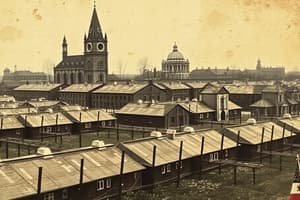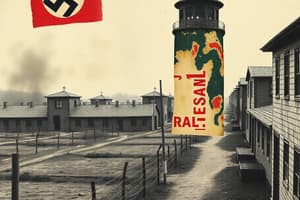Podcast
Questions and Answers
What was the primary purpose of the initial Nazi concentration camps established in 1933?
What was the primary purpose of the initial Nazi concentration camps established in 1933?
- To serve as extermination centers for Jews and other targeted groups.
- To provide labor for German industries and support the war effort.
- To detain political opponents and perceived enemies of the Nazi regime. (correct)
- To house prisoners of war captured during military conflicts.
Which of the following groups were NOT primary targets of persecution and imprisonment in Nazi concentration camps?
Which of the following groups were NOT primary targets of persecution and imprisonment in Nazi concentration camps?
- Jehovah's Witnesses.
- German citizens who supported the Nazi regime. (correct)
- Roma (Gypsies).
- Homosexuals.
How did Nazi ideology contribute to the atrocities committed in concentration camps?
How did Nazi ideology contribute to the atrocities committed in concentration camps?
- By encouraging individual freedom and protection of human rights.
- By emphasizing the belief in racial hygiene and the superiority of the Aryan race. (correct)
- By advocating for international cooperation and peaceful resolution of conflicts.
- By promoting religious tolerance and acceptance of diverse cultural traditions.
What role did the SS (Schutzstaffel) play in the operation of Nazi concentration camps?
What role did the SS (Schutzstaffel) play in the operation of Nazi concentration camps?
What was the significance of the Nuremberg Trials following World War II?
What was the significance of the Nuremberg Trials following World War II?
Besides Jews, which other group suffered widespread persecution and genocide in Nazi concentration camps?
Besides Jews, which other group suffered widespread persecution and genocide in Nazi concentration camps?
What was the role of 'Kapos' within the Nazi concentration camp system?
What was the role of 'Kapos' within the Nazi concentration camp system?
Which of the following best describes the conditions prevalent in Nazi concentration camps?
Which of the following best describes the conditions prevalent in Nazi concentration camps?
What was the primary purpose of extermination camps like Auschwitz-Birkenau, Treblinka, and Sobibor?
What was the primary purpose of extermination camps like Auschwitz-Birkenau, Treblinka, and Sobibor?
What impact did the liberation of Nazi concentration camps have on the world's understanding of the Holocaust?
What impact did the liberation of Nazi concentration camps have on the world's understanding of the Holocaust?
Why is education about the Holocaust considered crucial in contemporary society?
Why is education about the Holocaust considered crucial in contemporary society?
What distinguishes the Holocaust from other instances of genocide in human history?
What distinguishes the Holocaust from other instances of genocide in human history?
What was the purpose of transit camps within the Nazi concentration camp system?
What was the purpose of transit camps within the Nazi concentration camp system?
How did some prisoners resist the Nazi regime within concentration camps?
How did some prisoners resist the Nazi regime within concentration camps?
How did the experiences of POWs in Nazi Germany generally differ from those of concentration camp prisoners?
How did the experiences of POWs in Nazi Germany generally differ from those of concentration camp prisoners?
What was the significance of subcamps and satellite camps within the Nazi concentration camp system?
What was the significance of subcamps and satellite camps within the Nazi concentration camp system?
How did Nazi racial theories influence the treatment of Soviet POWs compared to Allied POWs from Western countries?
How did Nazi racial theories influence the treatment of Soviet POWs compared to Allied POWs from Western countries?
In what ways do former Nazi concentration camps serve as important sites of remembrance and education today?
In what ways do former Nazi concentration camps serve as important sites of remembrance and education today?
What role did corporations and businesses play in the Nazi concentration camp system?
What role did corporations and businesses play in the Nazi concentration camp system?
Flashcards
Nazi Concentration Camps
Nazi Concentration Camps
Prison camps used by Nazi Germany during World War II, initially for political opponents and later for systematic persecution and extermination.
Schutzstaffel (SS)
Schutzstaffel (SS)
The SS, a Nazi paramilitary organization, operated and administered the concentration camps.
Concentration Camps
Concentration Camps
The most common type of camp, used for forced labor, detention, and murder of prisoners.
Extermination Camps
Extermination Camps
Signup and view all the flashcards
Camp Conditions
Camp Conditions
Signup and view all the flashcards
Nazi Ideology
Nazi Ideology
Signup and view all the flashcards
Targeted Groups
Targeted Groups
Signup and view all the flashcards
The Holocaust
The Holocaust
Signup and view all the flashcards
Extermination Camps
Extermination Camps
Signup and view all the flashcards
Key SS Figures
Key SS Figures
Signup and view all the flashcards
Control Methods
Control Methods
Signup and view all the flashcards
Camp Population & Deaths
Camp Population & Deaths
Signup and view all the flashcards
Liberation of Camps
Liberation of Camps
Signup and view all the flashcards
Impact of Liberation
Impact of Liberation
Signup and view all the flashcards
Nuremberg Trials
Nuremberg Trials
Signup and view all the flashcards
Sites of Remembrance
Sites of Remembrance
Signup and view all the flashcards
Other Victims
Other Victims
Signup and view all the flashcards
Subcamps
Subcamps
Signup and view all the flashcards
Prisoner Resistance
Prisoner Resistance
Signup and view all the flashcards
Holocaust Uniqueness
Holocaust Uniqueness
Signup and view all the flashcards
Study Notes
- Nazi concentration camps were prison camps used during World War II by Nazi Germany.
- The camps were operated by the SS, Schutzstaffel.
- The first camps were established in Germany in March 1933, immediately after Hitler became Chancellor.
- These initial camps targeted the regime’s political opponents and perceived enemies.
- The camps quickly grew in number and expanded into German-occupied Europe.
- From 1933 to 1945, Nazi Germany operated over a thousand camps.
- Several types of camps existed.
- Concentration camps were the most common, used for forced labor, detention, and murder.
- Extermination camps were specifically designed for mass murder, primarily through gassing.
- Prisoner-of-war (POW) camps were for captured enemy soldiers.
- Transit camps temporarily held prisoners before transport to other camps.
- Conditions in Nazi concentration camps were brutal.
- Prisoners endured forced labor, starvation, torture, and medical experimentation.
- Overcrowding, poor sanitation, and rampant disease characterized the camps.
- Many prisoners died due to these conditions.
- Nazi ideology was crucial in establishing and operating the concentration camps.
- The Nazis believed in racial hygiene and the superiority of the Aryan race.
- They aimed to eliminate those considered inferior or threats to Aryan purity.
- Jews were the primary target, disproportionately represented in the camps.
- Other targeted groups included Roma (Gypsies), political opponents, homosexuals, disabled people, Jehovah's Witnesses, and others deemed "asocial".
- The Holocaust was the systematic, state-sponsored persecution and murder of six million Jews by the Nazi regime and its collaborators.
- Nazi concentration camps played a central role in the Holocaust.
- Extermination camps like Auschwitz-Birkenau, Treblinka, and Sobibor were designed for the mass murder of Jews.
- Other concentration camps contributed through forced labor, starvation, and systematic brutality.
- The SS was responsible for administering and operating the camps.
- Key SS figures like Heinrich Himmler and Reinhard Heydrich were instrumental in planning and implementing the Holocaust.
- The SS used methods to maintain control, including Kapos (prisoners with privileges) and brutal punishments.
- The number of prisoners varied greatly over time and across different camps.
- At its peak, the camp system held hundreds of thousands of prisoners.
- Millions passed through the camps during the Nazi regime's 12 years.
- The death toll is estimated to be in the millions.
- The majority of those who died were Jews, but significant numbers of other groups also perished.
- The exact number of deaths is difficult to determine due to incomplete records and chaotic conditions at the end of the war.
- As Allied forces advanced, they began liberating the camps.
- Majdanek was the first major camp liberated in July 1944 by the Soviet Red Army.
- Allied forces also liberated Auschwitz-Birkenau, Buchenwald, Dachau, and other camps.
- The liberation revealed the full extent of Nazi atrocities.
- The discovery of mass graves, gas chambers, and emaciated survivors shocked the world.
- The liberation had a profound impact.
- The horrors of the Holocaust led to a greater understanding of the dangers of intolerance, racism, and extremism.
- The atrocities significantly influenced the development of international human rights laws and the establishment of the United Nations.
- Many Nazi officials and SS officers were brought to justice after the war.
- The Nuremberg Trials (1945-1949) prosecuted high-ranking Nazi leaders for war crimes, crimes against humanity, and crimes against peace.
- Lower-level officials were also prosecuted in subsequent trials.
- The pursuit of justice for victims continues.
- Nazi concentration camps are now important sites of remembrance and education.
- Former camps like Auschwitz-Birkenau and Dachau have been preserved as museums and memorials.
- These sites serve as reminders of Nazi atrocities and warnings against future acts of genocide.
- Survivor testimonies and historical research are essential for understanding the Holocaust and preserving its memory.
- These accounts provide valuable insights into the experiences of prisoners and the broader context of the Holocaust.
- Holocaust education is crucial for promoting tolerance, preventing discrimination, and safeguarding human rights.
- Several organizations and initiatives are dedicated to Holocaust education and remembrance worldwide.
- These efforts aim to ensure that the lessons of the Holocaust are never forgotten.
- While the focus is often on Jewish victims, it's important to remember other groups also suffered.
- Political prisoners: Individuals who opposed the Nazi regime were imprisoned.
- Roma (Gypsies): Subjected to racial persecution and genocide.
- Homosexuals: Persecuted and imprisoned for their sexual orientation.
- Disabled persons: Targeted for euthanasia and forced sterilization.
- Jehovah's Witnesses: Persecuted for their religious beliefs and refusal to support the Nazi regime.
- The Nazi regime operated numerous subcamps and satellite camps connected to larger concentration camps.
- These smaller camps were often located near factories or other workplaces where prisoners were forced to labor.
- Subcamps provided additional labor resources for the Nazi war effort.
- The construction and maintenance of concentration camps required a vast network of resources and infrastructure.
- The Nazi regime utilized forced labor from the camps to produce goods and materials for the war effort.
- Companies and individuals profited from the exploitation of concentration camp prisoners.
- Many prisoners attempted to resist the Nazi regime within the concentration camps.
- Resistance efforts included acts of sabotage, escape attempts, and organizing underground resistance movements.
- Some prisoners formed international solidarity networks to support one another and share information.
- Despite the immense challenges and risks, resistance within the camps played a crucial role in maintaining hope and dignity.
- The term "prisoner of war" (POW) refers to a person who has been captured and imprisoned by the enemy during war.
- The treatment of POWs is governed by international laws and conventions, such as the Geneva Conventions.
- During World War II, both Allied and Axis powers held POWs in camps.
- The treatment of POWs varied depending on the country holding them and the specific circumstances of the war.
- German treatment of Allied POWs generally followed the Geneva Conventions, though there were instances of abuse and mistreatment.
- Soviet POWs held by Germany experienced horrific conditions and extremely high mortality rates, due to Nazi racial ideology and disregard for international law.
- Allied POWs held by Japan also suffered brutal treatment, forced labor, and high mortality rates.
- This was because Japan did not fully adhere to the Geneva Conventions.
- The experiences of POWs in Nazi Germany differed significantly from those of concentration camp prisoners.
- POWs were typically treated according to international laws and conventions, while concentration camp prisoners were subjected to systematic persecution and genocide based on race, religion, or political beliefs.
- POWs were usually military personnel, while concentration camp prisoners included a wide range of civilians and political opponents.
- While POW camps were generally focused on detention and labor, concentration camps were designed for extermination and mass murder.
- While POWs were technically protected by international agreements, the Nazi regime often violated these protections, particularly in the case of Soviet POWs.
- Nazi ideology played a significant role in the differential treatment of prisoners during World War II.
- Nazi racial theories led to the dehumanization and persecution of certain groups, such as Jews, Roma, and Soviet POWs.
- These groups were considered racially inferior and were subjected to extreme brutality and extermination.
- The Nazi regime viewed the war as a racial struggle and justified the mistreatment of its enemies based on these racial beliefs.
- The intersection of POW camps and concentration camps occurred in certain situations during World War II.
- Some POWs were transferred to concentration camps for various reasons, such as suspicion of resistance activities or for forced labor.
- In some cases, POWs were used in projects that bordered on slave labor, blurring the lines between POW status and concentration camp imprisonment.
- The experiences of these POWs highlighted the complex and overlapping nature of the Nazi system of oppression.
- The Holocaust was a unique and unprecedented event in human history.
- No other genocide has been carried out with the same level of systematic planning, technological efficiency, and ideological justification.
- The Holocaust serves as a stark reminder of the dangers of unchecked power, intolerance, and hatred.
- It is essential to learn from the Holocaust and to remain vigilant against all forms of discrimination and persecution.
Studying That Suits You
Use AI to generate personalized quizzes and flashcards to suit your learning preferences.




